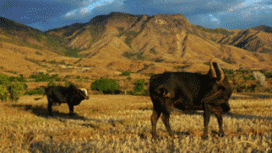This post was originally published on the Bioversity International website.
Emile Frison, Director General, Bioversity International, is currently attending the IUCN World Conservation Congress in Korea where he took part in: 'From Competition to Collaboration between Agriculture and Conservation. Here he shares his thoughts about why it is so important for agriculture and conservation agendas to come together:
"For some time, agriculture and conservation have operated in separate worlds with separate agendas. Agriculture has been seeking ways to increase production to feed a growing population, while conservation has been in a race to save more land for preservation purposes. "
 Taking an ecological approach to farming can bring agriculture and conservation together.
Taking an ecological approach to farming can bring agriculture and conservation together.Photo Credit: Bioversity/D. Hunter
At the same time, our world is reaching a tipping point – with an expected 9 billion people in the world by 2050 and climate change already having effects with major droughts and floods. We need to collaborate and find ways to prevent catastrophe and also insure our futures and those of generations to come.
What does this collaboration look like? For farmers in some of the world’s poorest areas, it includes adding more diversity on farms to diversify production and improve the resilience of food production systems, while at the same time increase pollination and maintain healthy soils. It means policy makers need to advocate for an ecological approach to farming and protecting smallholder farmers. It means farms are seen as parts of diverse mosaic landscapes including corridors that link natural ecosystems and allow wildlife to prosper at the same time as agriculture. It means approaching agriculture not for the short term, but for a sustainable future.
Bioversity International is working with partners to conduct more research and provide critical decisionmaking information in this area. This research will result in decision making tools for policy makers, land managers, conservationists, and farmers – giving them more options in a world running out of time to meet production and conservation goals. Examples include EcoAgriculture Partners’ Landscapes for People, Food and Nature initiative, the Natural Capital Project, CGIAR’s Water, Land and Ecosystems research program, and of course this week’s workshops at IUCN.
Biodiversity is a significant factor in all of these examples, because it is in an excellent position to contribute to both agriculture and conservation. Farming systems have to transform, while conservation efforts need to ramp up to halt the everyday loss of biodiversity, including in agricultural landscapes and not just in protected areas.
Genebanks make up an important part of the efforts to conserve plant genetic diversity, but the world’s farms have to play a critical role in this effort through a dynamic form of conservation. Smallholder farmers in particular – many of whom are women – are the custodians and users of biodiversity. The choices they make in the varieties they plant, grow, harvest and sell directly also affect the diversity in our diets, our supermarkets and on our tables.
This approach is already under way, but needs more support. Research to provide healthy, resilient, sustainable ecosystem services is needed now. These services involve the entire interplay of social, cultural, ecological and financial dimensions. Interdisciplinary and cross-sectoral cooperation is vital. Become our partner in this effort.
Find out more about what Bioversity International is doing at the IUCN World Conservation Congress here.

















Comments
Reblogged this on Nyalugwe.
This is a wonderful article which links the concept of conservation to Agriculture. We should not forget the fact that an agricultural farm is also an ecosystem. Sustaining the natural surrounding and the communities involved in any agricultural activity (such as growing vegetables, doing mixed farming or animal breeding) should be a priority. This point should be focused, especially in a time where issues such as soil nutrient depletion, global warming and depletion of underground aquifers are a fact.
I like your blog. Interesting, clear and precise. Thank you for the info Emile.